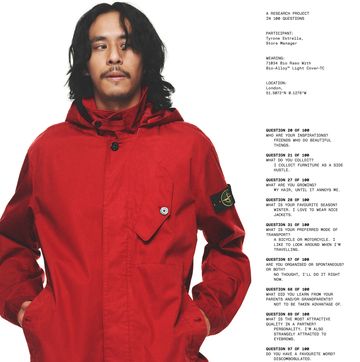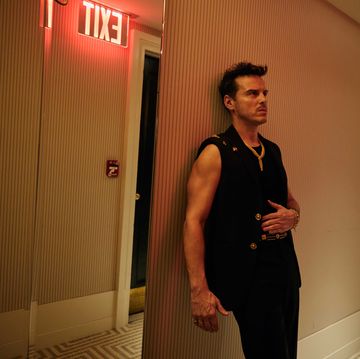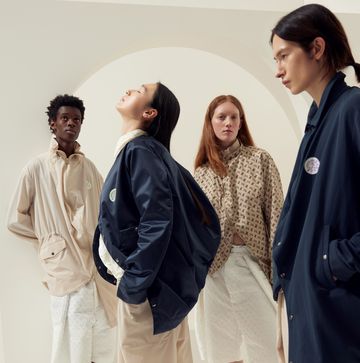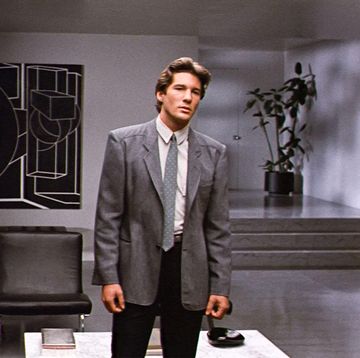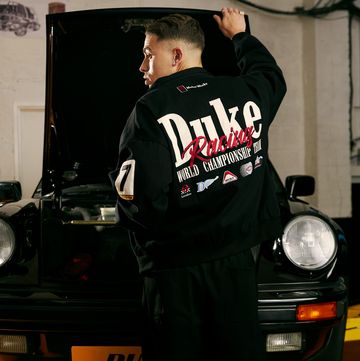The New York Times recently ran an interview with Ben Schott, author of the Schott’s Original Miscellany series. The occasion marked the publication of his new book, Jeeves and the King of Clubs — an homage to PG Woodhouse’s famous creation. Among the questions put to Schott, one stood out: the interviewer wanted to know the provenance of Schott’s trousers. (Or, since this was for an American audience, his pants.)
“Are those proper sitting room pants you’re wearing?”
“You could wear them to a club,” Schott countered. “These are from Topolina, in Marrakesh. It’s like a Marrakesh Pucci. It’s a stunning shop.”
The accompanying photo showed Schott in said stunning pants: blue and white chequerboard affairs that resembled pyjama bottoms. He had teamed them with a grey knitted cardigan/jacket, a floppy white shirt and what might have been Car Shoes or slippers (no socks). Propping up his fireplace in Highgate, north London, surrounded by hardbacks and soft furnishings, he looked every bit the dandy writer in residence (his own).
Dressed up yet down, he surfed the choppy waters of smart casual with style. It was the kind of outfit that said, “I’m off to bed in a minute” while simultaneously being somehow appropriate for when The New York Times photographer popped round to take your photo.
Not long ago, if I were to imagine some alternate universe where The New York Times’ photographer popped round to take my photo I’d have worn a suit. Maybe even a tie. But times have changed. Two thousand and nineteen would not be a good time to get into the necktie business.
“I was having a meeting with a department store,” Oliver Spencer tells Esquire, “and they basically said they were going to close down their suit department completely. They wanted us to come in, along with a few other [designers], and deliver super-unstructured jackets and relaxed tailoring. Guys just aren’t wearing suits anymore. It’s the sign of being an… estate agent, or some other kind of profession.”
Happy days then for Spencer, who has been selling super-unstructured and relaxed tailoring since 2002. And it’s since then we’ve seen the birth of loungewear (high-spec T-shirts and sweatshirts), and athleisure take hoodies from council estate to catwalk. This season, Tom Ford is selling a black cotton-jersey hooded top for £2,690. That’s quite punchy for a hoodie, but lest anyone were cynical enough to think brands were simply coming up with new categories, or rebranding old ones, merely to sell us more stuff, the demand is there.
Almost four million people in the UK now work from home. Factor in nesting, Netflix and the booming sales of smoked salmon and other dinner party perennials, and a wardrobe of pressed shirts and Sunday best seems obsolete.
Allow us, then, to make the case for the rise of a new category. Let us call it “louchewear”. The sort of clothing that bridges the gap between structured ready-to-wear and slouchy sleepwear.
“We keep hearing it’s all about ‘streetwear’ and ‘athleisure’,” says Isabel Ettedgui, owner of Connolly in Mayfair. “But I think men are still obsessed with detailing and tailoring and you have to combine the two to get it right. An Englishman has never been very good at leisure clothing. An Englishman on holiday has always been a slight...”
Eyesore?
“Eyesore, yes! So it’s about movement and ease but you’re not in a tracksuit.”
“There’s a new definition of style now, where men are looking for luxury and comfort at the same time,” says Alessandro Sartori, artistic director at Ermenegildo Zegna. “It’s a wardrobe that can be worn for formal meetings or leisure.”
Italian brand Corneliani has invested big in fabric innovations, notably silks, to keep pace with its customer. One capsule collection is called “Style & Freedom”.
“For winter, we did a more elegant version of Style & Freedom, called ‘In-House’,” says Corneliani style director Stefano Gaudioso Tramonte. “These are garments that you can wear when you invite people to dinner. Jackets with a raglan shoulder, pants in jersey with a drawstring at the waist. You don’t wear a suit, you wear something more deconstructed. And if you go out, you can go out dressed like that and everybody would accept it. That’s the idea. But I would not call it ‘streetwear’!”
What we need here, Esquire decided, was a convert’s opinion. So we called up Ben Schott and asked him for one.
“This infantilisation of clothing where everybody just wants to be in a romper suit the entire time is extremely odd,” he said. “If you have to come home and rip your clothes off because they’re so horrifically uncomfortable, then why not wear clothes that you feel comfortable in all the time? When I’m dressed, I’m pretty much dressed for anything.”
They weren’t slippers or Car Shoes, by the way. They were slip-ons handmade on the Amalfi Coast, where the Schotts holiday every year. “They just melt into your feet”.








